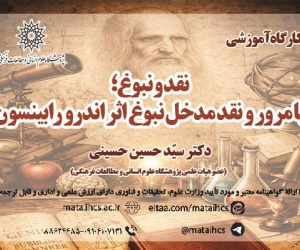آثار و دیدگاه طبیعت گرایانه ی آلبرشت دورر (مقاله علمی وزارت علوم)
درجه علمی: نشریه علمی (وزارت علوم)
آرشیو
چکیده
دیدگاه طبیعت گرایانه در دوران رنسانس با اضافه شدن رویکردهای علمی منجر به آگاهی بیشتر انسان از پیرامونش شد. کوشش هنرمندان در به نمایش گذاشتن جهان سبب شد تا هنر رنسانس از دوره های گذشته به طرز چشم گیری متمایز شود. جریانی که انسان و طبیعت را سرلوحه قرار داد و با دو گرایش عمده ی واقع گرایی، یکی مبتنی بر تجربه و مشاهده ی طبیعت و دیگری توسل به ریاضیات، به سمت کشف جهان عینی گام برداشت. از این رو، مطالعه ی نگرش هنرمندی که در فعالیت حرفه ای خود در مواجهه با این گرایش ها قرار گرفته است موضوع مهمی در تحلیل آثار تصویری محسوب می شود که در این پژوهش به شکلی هدف مند در آثار آلبرشت دورر دنبال می شود. این که هنرمند در راستای تصویرسازی و نقاشی از چه مؤلفه هایی در طبیعت و چه تکنیک هایی بهره می گیرد سؤال اصلی این پژوهش است. بدین منظور، این مطالعه با اتخاذ شیوه ی توصیفی-تحلیلی و رویکرد تک نگاری به تحلیل عناصر بصری، ریاضی وار و طبیعت محور تصویرسازی ها می پردازد. از مهم ترین نتایج این مطالعه رویکرد متفاوت هنرمند در پرداخت به آثار است و نقش هنرمند در فرم دهی به عینیت گرایی در قالبی جدید به نمایش گذاشته می شود و هنرمند با تمام تأثیرپذیری از معیارهای زیباشناسانه ی رنسانس، در اجرا، به آن چه خود از موضوع درک کرده رجوع می کند.Exploring the Artworks and Naturalistic Perspective of Albrecht Dürer
The naturalistic perspective has been formed in the human subconscious since the beginning of history. In the Renaissance period, this attitude, alongside the scientific approach, gradually led to greater perception and understanding of nature. Artists' efforts to represent the objectives made Renaissance art remarkably distinct from previous periods. A movement that prioritized man and nature, and regarding two main trends of naturalism, one based on experience and observation of nature, in Northern Europe, and the other, based on mathematics, in Italy, took a step towards discovering the universe. Accordingly, the study of the perspective of an artist who has faced these trends in his professional activity is considered an important issue in the analysis of the works of illustration of this period, which is pursued in this study aimed at Albrecht Dürer’s works. Dürer, an artist from Nuremberg, is considered one of the greatest artists of the Northern Renaissance due to his paintings, engravings, scientific books based on anatomy and perspective, and innovations in printing techniques. He was the first artist outside of Italy who was able to achieve international fame in his time. He dedicated his life in search for the world's beauty. A world full of mystery, and the desire to understand it made him travel, observe nature, and get to know other artists. By retaining what he had learned in his hometown and his perception of Italian artists’ viewpoint, he effectively combined these two critical concepts. The main purpose of this study is to see how far the artist takes this naturalistic idea that existed in Northern Europe, and in what cases he refers to Italian artists and theorists. For this purpose, the theoretical discussion includes the description of the definitions and basic concepts in the field of nature and its role in art, before and after the Renaissance, and the research focus is devoted to the investigation and analysis of visual, mathematical, and nature-related expressive elements. One of the most important findings of this study is the artist's different approach. Undoubtedly, Dürer has always been fascinated by nature. By extending his repertoire in various techniques, he defined an independent identity for nature's elements in his artworks. This point of view basically refers to various approaches concerning each element of nature (trees, plants, and animals). Nature is expressive, and this is the artist's duty to observe, search and take steps toward discovering it. He works ambitiously in representing landscapes with watercolor technique, which shows that he is not obsessed solely with forms. His depiction of color, light, and atmosphere is reminiscent of Impressionist artworks. Also, the expression of phenomena and natural cycle of life is another aspect of his work. On the other hand, in prints, the artist's focus is not only on the story but also on proportions, perspective, and details. Considering the influence of the artist on the aesthetic standards of the Renaissance, some of his later illustrations present a new form of artistic creation, a depiction that was based on the artist’s perception.









